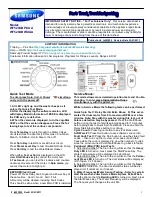
5
Dishwasher Use
Prepare and Load the Dishwasher
IMPORTANT: Remove leftover food, bones, toothpicks and other
hard items from the dishes. Remove labels from containers before
washing.
10 Place load pattern (when silverware basket is in
lower rack)
12 Place load pattern (when silverware basket is on the
door)
■
Make sure that when the dishwasher door is closed no items
are blocking the detergent dispenser.
■
Items should be loaded with soiled surfaces facing down and
inward to the spray as shown. This will improve cleaning and
drying results.
■
Avoid overlapping items like bowls or plates that may trap food.
■
Place plastics, small plates and glasses in the upper rack.
Wash only plastic items marked “dishwasher safe.”
■
To avoid thumping/clattering noises during operation: Load
dishes so they do not touch one another. Make sure lightweight
load items are secured in the racks.
Add Detergent
NOTE: If you do not plan to run a wash cycle soon, run a rinse
cycle. Do not use detergent.
■
Use automatic dishwasher detergent only. Add powder, liquid
or tablet detergent just before starting a cycle.
■
Fresh automatic
dishwasher
detergent results in
better cleaning.
Store tightly closed
detergent container
in a cool, dry place.
■
For optimum
performance, tablet
detergent is
recommended.
■
The amount of detergent to use depends on:
How much soil remains on the items - Heavily soiled loads
require more detergent.
The hardness of the water - If you use too little in hard water,
dishes won't be clean. If you use too much in soft water,
glassware will etch.
Soft to Medium Water (0-6 grains per U.S. gallon)
[typical water softener water and some city water]
Medium to Hard Water (7-12 grains per U.S. gallon)
[well water and some city water]
■
Depending on your water hardness, fill the Main Wash section
of the dispenser as shown. Fill the Pre-Wash section to the
level shown, if needed.
NOTE: Fill amounts shown
are for standard powdered
detergent. Follow instructions
on the package when using
other dishwasher detergent.
Add Rinse Aid
■
Your dishwasher is designed to use rinse aid for good drying
performance. Without rinse aid your dishes and dishwasher
interior will have excessive moisture. The heat dry option will
not perform as well without rinse aid.
■
Rinse aid keeps water from forming droplets that can
dry as spots or streaks. They also improve drying by
allowing water to drain off of the dishes after the final
rinse.
■
Rinse aid helps to reduce excess moisture on the
dish racks and interior of your dishwasher.
■
Check the rinse aid indicator. Add rinse aid when indicator
drops to “Refill” level.
■
To add rinse aid, turn the dispenser
cap to “Open” and lift off. Pour rinse
aid into the opening until the
indicator level is at “Full.” Replace
the dispenser cap and turn to
“Lock.” Make sure cap is fully
locked.
STEP 1
Upper rack
Lower rack
Upper rack
Lower rack
■
Make sure nothing keeps spray arm(s) from
spinning freely. It is important for the water
spray to reach all soiled surfaces.
■
When loading silverware, always place sharp
items pointing. Mix other items pointing up
and some pointing down.
STEP 2
A
B
C
MAIN WASH
PRE-
WASH
Soft Water
Hard Water
Soft Water
Hard Water
A. Cover latch
B. Main Wash section
C. Pre-Wash section
Soft Water
Hard Water
Soft Water
Hard Water
Main Wash
Pre-Wash
Full
Add
Lock
Refill
6 5
4
3
2
- -
-
max
fill
1
- -
-
-
- - -
-
-
-
-
¹⁄₄
turn to lock






































